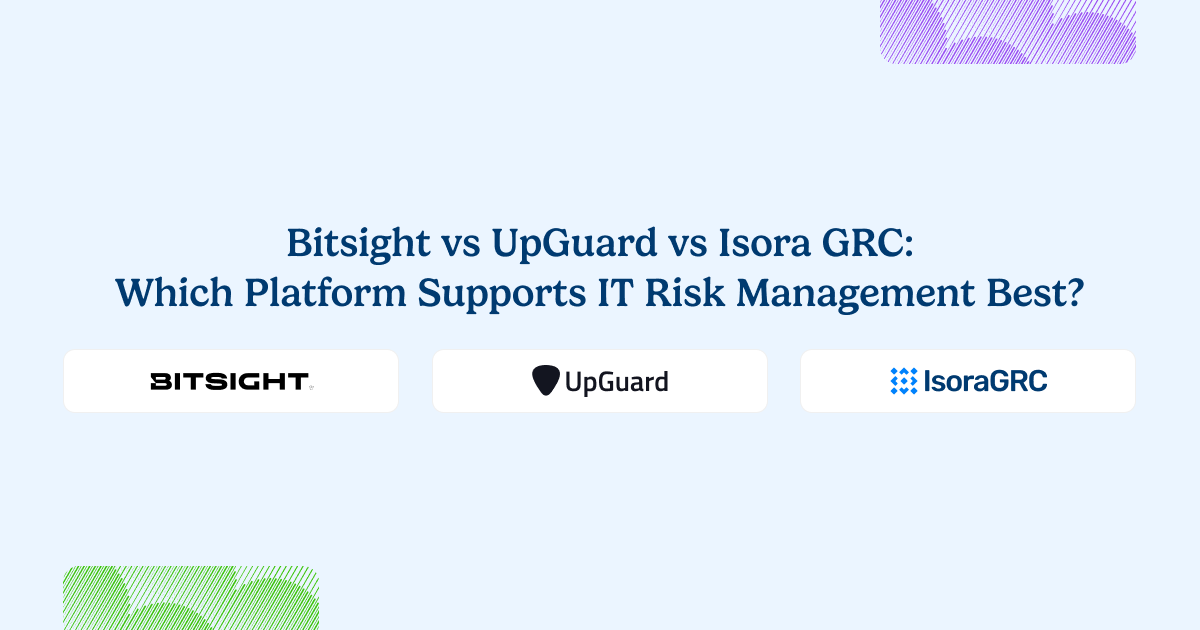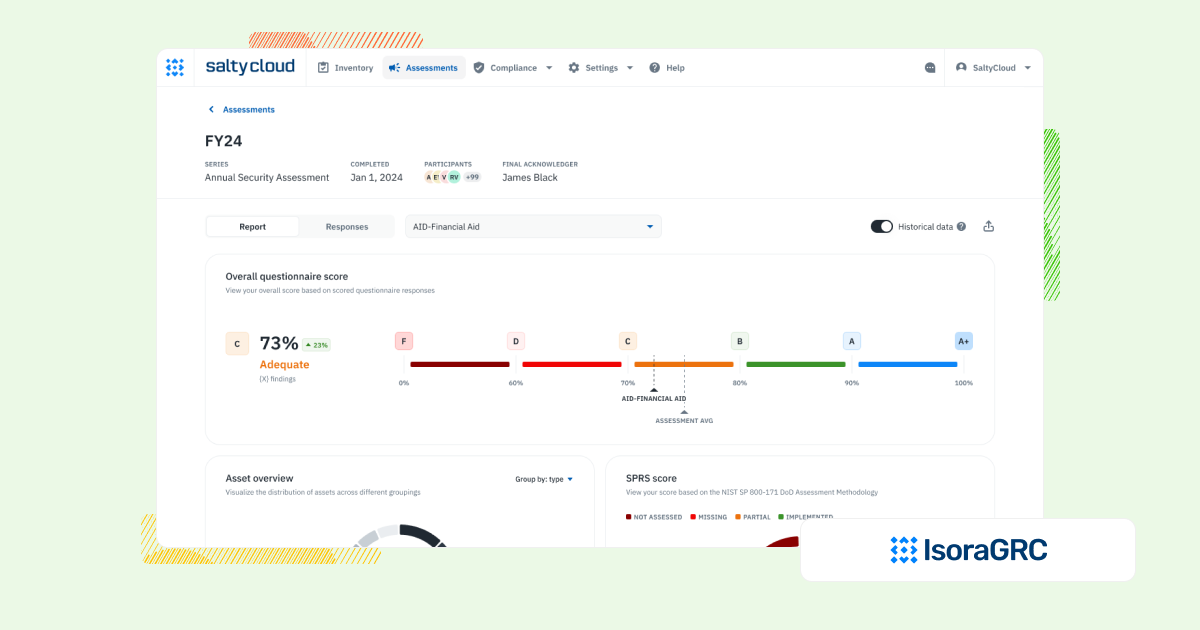
Every security team needs a structured, scalable way to manage IT risk—not just watch third-party ratings.
Platforms like Bitsight and UpGuard specialize in vendor intelligence, offering external scores to flag potential risks across supply chains and partners.
External scores can highlight issues, but they don’t help you assess, track, or resolve them through deeper, ongoing workflows.
Isora GRC focuses on what truly matters. It’s purpose-built for security teams who need to run real assessments, manage inventories, and track risks—moving beyond surface-level scores to full risk management.
Let’s review this closely.
Choosing the Right Platform for IT Risk Management
BitSight and UpGuard offer continuous external monitoring of vendor security posture. While this can be a useful signal, it doesn’t replace structured assessment workflows. Neither tool enables you to send questionnaires, gather documentation, assign risk owners, or track exceptions—all critical components of a mature third-party risk program.
Isora GRC closes that gap. It enables vendor assessments based on your requirements, organizes responses, highlights exceptions, and feeds results directly into a risk register. It also integrates with your asset and vendor inventory, giving you complete visibility into how third parties map to business-critical systems.
The Workflow That Matters: Managing IT Risks and Compliance
Real vendor risk management happens through engagement—not just observation. Scanning tools like BitSight and UpGuard might alert you to potential issues, but they can’t help you investigate those issues, verify controls, or escalate concerns to internal stakeholders.
Isora GRC helps you operationalize the process. It supports repeatable assessment cycles, centralized communication, versioning across quarters, and full visibility into vendor relationships. With built-in reporting and accountability workflows, it turns third-party risk into a continuous, trackable practice—not a spreadsheet exercise.
How Each Platform Supports IT Risk Management Workflows
| Workflow Area | Bitsight | UpGuard | Isora GRC |
| Assessment Management | BitSight tracks security ratings and third-party risks. But it may lack full assessment management features. | UpGuard offers strong tools for assessments, security ratings, and leak detection. Still, some users say it takes time to learn the platform. | Centralized, intuitive assessment dashboard across business units, vendors, and assets. Built specifically for security teams. |
| Questionnaire Delivery & Completion | BitSight focuses on ratings, not on forms. Teams needing strong questionnaire tools may need extra help. | The system handles questionnaires well. But users wanting deep customization might feel limited. | Customizable and prebuilt questionnaires for frameworks like NIST, ISO, GLBA, HIPAA, and more. Designed for internal and external collaboration. |
| Inventory Tracking | BitSight looks at external security, not asset tracking. This can limit teams with large inventories. | UpGuard checks vendors and their security levels. Still, full asset tracking is not the main focus. | Centralized tracking of assets, vendors, and organizational units with integration support for existing data sources. |
| Risk Register & Exception Management | Insights on third-party risk exist, but deeper risk tracking is missing. Extra tools may be needed. | Risk tools exist, but advanced features may need expert help. Less technical users could struggle. | Flexible, collaborative risk register with scoring, status, evidence, and ownership tied directly to assessments. Exception management is built-in and intuitive—no extra modules or configuration required. |
| Scoring, Reporting & Risk Visualization | Security scores come with insights, but risk visuals may feel too simple. | UpGuard includes security scores and reports. However, risk visuals may feel basic to some users. | Automated scorecards, risk maps, and executive-friendly reports with actionable insights—no manual config required. |
| Collaboration & User Experience | The interface suits security pros. Still, team collaboration tools feel limited. | The platform works well for tech users. But learning to use the collaboration tools may take time. | WCAG-compliant, award-nominated interface with built-in commenting, team workflows, and fast onboarding. |
| Implementation & Setup | Setup feels simple for security-focused teams. But those needing full GRC features may hit limits. | UpGuard needs time and resources to set up. Teams may need training and support for smooth use. | No-code setup in days or weeks. Minimal IT lift required. Designed to go live quickly across teams and vendors. |
What Sets Isora GRC Apart?

Isora GRC was purpose-built for information security teams—designed to support the real workflows behind risk and compliance, not just generate reports. While legacy GRC platforms require months of configuration and rigid processes, Isora takes a modern, scalable approach:
- Purpose-built for security and third-party risk teams
- No extra modules or cross-department bloat—just the workflows that matter.
- Easy for anyone to use
- Clean UI, no complex training, and built to drive adoption across the org.
- Streamlined for action, not just documentation
- Assessments, questionnaires, inventories, risk tracking, and reporting—all in one place.
- Fast, no-code implementation
- Go live in weeks, not quarters, with minimal IT lift.
- Scales with your program
- Whether you’re running a lean risk function or supporting a large institution, Isora grows with you—without getting in the way.
Who Each Platform Is Best For
| Platform | Who It’s For |
| Bitsight | Companies tracking risk scores for vendors. Looks good on reports but doesn’t dig deep. |
| UpGuard | Getting a quick view of vendor security from the outside. Helpful info, but not a full-risk solution. |
| Isora GRC | Security teams that need a scalable, usable IT risk management program across their organization. |
What Our Customers Say About Isora GRC
Security teams at top institutions are using Isora GRC to replace legacy tools and manual processes with intuitive workflows and actionable insight.
“Moving from manual processes to using Isora was a breath of fresh air. What used to take months is now automated, reliable, and defensible. Isora saves us significant time while delivering accurate insights that improve decision-making.”
Jessica Sandy, IT GRC Manager, The University of Chicago
“Isora has been essential in helping us meet our University of California cybersecurity requirements across a decentralized campus. Automating assessment data collection and reporting has given us clear visibility into unit-level risks, enabling us to prioritize resources effectively and address gaps with confidence.”
Allison Henry, CISO, The University of California, Berkeley
FAQs
What’s the difference between BitSight, UpGuard, and Isora GRC?
BitSight and UpGuard provide external security ratings and breach monitoring based on internet-facing data. Isora GRC goes further by enabling teams to actively manage third-party risk—issuing questionnaires, maintaining vendor inventories, tracking exceptions, and managing remediation efforts.
Are BitSight and UpGuard considered vendor risk management platforms?
They’re best classified as vendor intelligence tools. While they offer visibility into third-party security posture, they lack the workflow capabilities needed to assess vendors directly, collect documentation, or assign follow-up tasks internally.
Does Isora GRC replace platforms like BitSight or UpGuard?
Yes, for teams looking to go beyond surface-level scores and into actionable vendor risk management. Isora allows organizations to assess vendors using frameworks like HECVAT, track responses, manage inventories, and handle exceptions—all within a collaborative platform.
Which platform is better for managing third-party risk across the organization?
Isora GRC is built for end-to-end third-party risk workflows. BitSight and UpGuard provide useful insights, but Isora helps teams operationalize vendor risk—supporting real collaboration, documentation, and continuous improvement.
Can Isora GRC be used alongside BitSight or UpGuard?
Yes. Some teams use BitSight or UpGuard for continuous monitoring, while relying on Isora GRC to drive actual assessment workflows, manage inventory data, and track vendor risk over time.
What should I look for in a vendor risk platform beyond vendor risk ratings?
Look for tools that support structured assessments, vendor engagement, inventory tracking, and exception resolution. Isora GRC delivers these capabilities, enabling teams to manage—not just monitor—third-party risk.



















 Other Relevant Content
Other Relevant Content